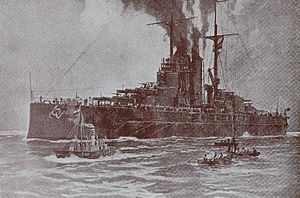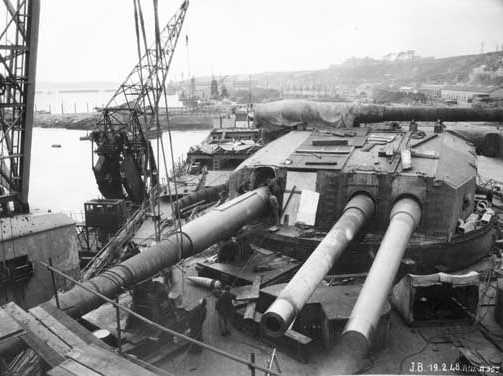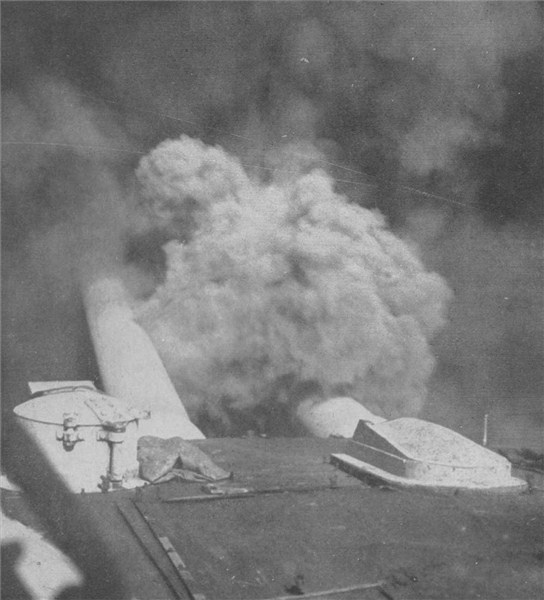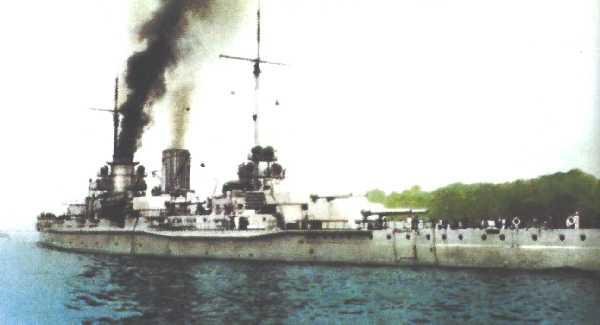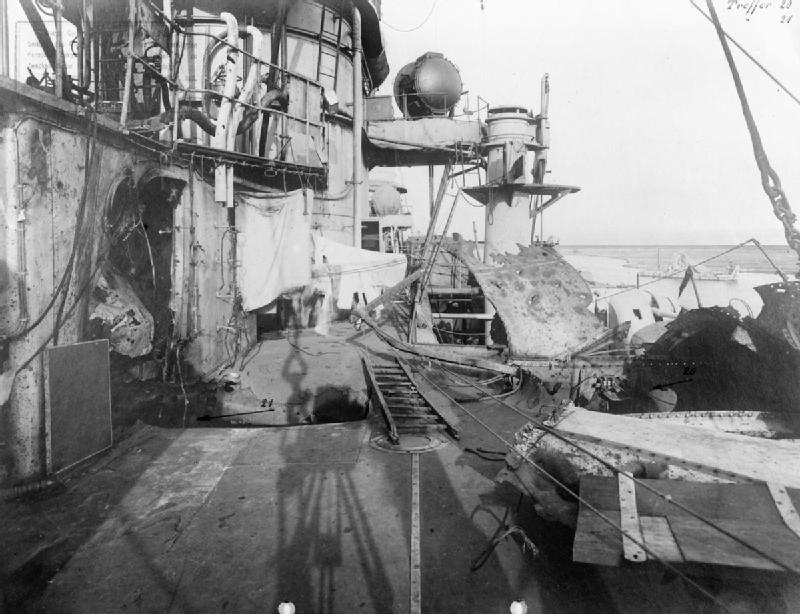I was reading about some of the battleship programs that were cancelled because of WW1 and I had the idea to write up alternate naval battles. I've got a few ideas kicking around for more but I'll wait and see how this one goes first. I apologize in advance for the wall of text, I do have images but I'm having trouble getting them to show up. When I do I'll edit them into the post. So without further ado....
The battlecruiser SMS Mackensen rocked as a shell tore into her. The heavy round ripped through Mackensen’s side armor to detonate just behind sparking secondary explosions and igniting several tons of coal which had been stored in the compartment behind the ships 12 inch armor plating. This was a feature of which the damage control teams were most definitely not fans. Below decks men raced through a world of darkness and smoke, desperately trying to ascertain the extent of the damage done to their charge. A man, his face smeared with soot and running with sweat sprinted up to Lieutenant Schaer
“Sir, the coal’s burning on this side too! We aren’t sure how far it’s spread yet but the fire’s big.” As the man coughed out his report there was a boom and the ship rocked again. Less violently this time but still enough to knock men from their feet and send one mechanic crashing into the mass of pipes he was working on. His nearest comrade grabbed the man by the arm and hauled him to his feet, blood dripping from both nostrils. Without words the nameless mechanic resumed his task.
“Secondary explosion.” spat Schaer. He thought for a moment, weighing his options. “Flood all of the burning compartments and make sure the fire doesn’t spread to any of the other bunkers. Flood the whole fucking ship if you have to.”
“Aye, sir”
Schaer turned and started to climb up the stairway to his back only to be unceremoniously shoved out of the way by two sailors rushing a heavy toolbox down the stars. In normal circumstances that would have been worth a spell in the brig but there was a popular saying among the younger officers of the fleet. “Under fire, the mechanic outranks everyone.”
Mackensen was most certainly under fire. That much was obvious when Schaer stepped out of the top of the stairway and onto a walkway that led past the aft funnel towards the bridge. Schaer paused and gazed at the sea behind the battlecruiser. His gaze passed over the wreck of a 5.9 inch gun, the gun had been shorn from it’s mounting on one side and hung crazily from one side it’s base pointed into the remnants of it’s casemate. The remnants of it’s crew formed a puddle around the base.
Schaer lingered for a moment and turned away. As he took a step the world was replaced by a flash of light, and heat, and noise, and then all was darkness.
Schaer had chosen a poor moment to emerge on deck. At that same moment as 13.4 inch, 1300 lb, high explosive shell crashed into the funnel seven feet above the walkway Lieutenant Schaer had just started across. The lump of metal and explosive punched through the skin of the funnel, the thin sheet of gray steel barely provided enough resistance to trigger the detonator in the nose of the incoming shell. The resulting explosion completely wrecked Mackensen’s funnel, blowing a twelve foot hole in it’s side. This weakened the entire structure combined with the shock of the explosion toppled the remains of the funnel. Smoke billowed up around the wreckage of twisted metal.
12,000 meters distant from Mackensen was the French battlecruiser Aquitaine. Aquitaine was southwest of Mackensen but at 27 knots she was holding the range. A plume of water burst form the sea less that 10 meters from Aquitaine’s side, the jet a water rising up until it was of a height with the bridge. The spray mixed with cordite smoke to form a dense fog which temporarily shielded Mackensen from view. Captain Murand watched form Aquitaine’s armored conning tower as his ships forward turret belched forth a salvo. The four guns fired in quick succession first the far right, then the far left, then the inner right and lastly the inner left gun. The four 13.4 inch rifles hurled their deadly challenges at Mackensen. The shells following graceful ballistic arcs that took the shells hurtling through a wisp of cloud after which they nosed over and began the second half of their short flights. Three of the rounds landed in the sea. One did not. The fourth round hit Mackensen squarely on her stern. The armor piercing shell punched cleanly through the light 4 inches of armor over that section of hull and buried itself in the bowels of the ship where it detonated with sufficient force to rip a 10 foot hole in the stern deck and bulge the hull outwards in the surrounding area.
The aft most turret replied in kind to Aquitaine, the deep roar of its 13.8 inch guns a counterpoint to the higher bark of the secondary 5.9s. Just as the symphony of guns filled the air with ear splitting cracks and deep resonant booms so to did the fall of their shot fill the sea around the two ships. While the big main guns sought death blows the secondaries attempted to wreck their opponents topside. In this rate of fire was of greater importance than accuracy so while the main guns took what seemed a ponderously slow time between shots the light guns fired once every few seconds.
Captain Hetter was worried for his ship. Mackensen was the youngest ship in the Kaiser’s navy and from the look of things she would soon be its youngest casualty as well. She was holed beneath the waterline in at least one place and possibly two, there had been a very worrying fire in one of her outer coal bunkers that had only been put out when they flooded the compartment, her rear funnel had been downed and the same shell that had done that had taken several boilers off line. It was the boilers that most concerned him. His ship was one of the toughest battlecruisers afloat and could shake off most of the damage without cause for concern. At the moment though Hetter would gladly have traded his ships armor for more speed. As it was the damaged boilers meant Mackensen was only able to make 26 knots. The 1 knot advantage this handed to the French would enable them to close the distance between themselves and Mackensen. Under normal circumstances this would not have been and issue, Mackensen was much more heavily armored then her French counterpart. The two French ships in the distance were what made it an issue. Picardie and Champagne were Aquitaine’s younger and, if rumor was to be believed, improved sisters. If any of the French battlecruisers had been on their own Hetter would have turned to meet them. All three though, his ship had no chance against all three opponents. So he had run, and now it was looking like he could not run much longer. Night thought Hetter, Picardie and Champagne wouldn’t catch him before nightfall and if he could hold off Aquitaine they could lose the French under cover of darkness. Then they could double back around and make a run for the Channel at high speed. The Chief Engineer had told him that Mackensen could make 28 knots if she had to but eventually that would wreck the bodged engine repairs and after that Mackensen would be lucky to make 12 knots. Hetter was shaken from his contemplation by the deep thud of one of the main guns firing. The gun in question was in the left mounting of the aft superfiring turret and the shell it had just loosed flew at Aquitaine, hitting her forward turret just to the left of the central bulkhead. As it happened this particular spot had already been weakened by a previous impact earlier in the engagement. When the heavy armor piercing shell hit the metal gave way beneath it and allowing the shell to continue into the turret itself where it exploded, setting of the stock of ready-to-use ammunition and propellant bags. The resulting detonation ripped the entire turret from its mounting, in the process bursting the armored side like a balloon.
When the smoke cleared it was plain to all and sundry that Aquitaine was out of the fight. The turret had ended up on it’s side in the hole was the entire remains of the original mounting.
Hetter watched as Aquitaine turned away and retreated towards her advancing brethren. He sent up a silent prayer to any god who might be listening. He now had the reprieve Mackensen needed. Automatically, Hetter ordered subordinates to ensure the remaining daylight was used to repair the worst of the damage and, critically, douse any fires which might give away their position at night. There was a brief flurry of activity as the bridge emptied of officers hurrying to see to their tasks. Hetter closed his eyes and allowed himself a precious moment of rest. His ship and his crew were largely intact and they had escaped from the jaws of the enemy. For now.
The battlecruiser SMS Mackensen rocked as a shell tore into her. The heavy round ripped through Mackensen’s side armor to detonate just behind sparking secondary explosions and igniting several tons of coal which had been stored in the compartment behind the ships 12 inch armor plating. This was a feature of which the damage control teams were most definitely not fans. Below decks men raced through a world of darkness and smoke, desperately trying to ascertain the extent of the damage done to their charge. A man, his face smeared with soot and running with sweat sprinted up to Lieutenant Schaer
“Sir, the coal’s burning on this side too! We aren’t sure how far it’s spread yet but the fire’s big.” As the man coughed out his report there was a boom and the ship rocked again. Less violently this time but still enough to knock men from their feet and send one mechanic crashing into the mass of pipes he was working on. His nearest comrade grabbed the man by the arm and hauled him to his feet, blood dripping from both nostrils. Without words the nameless mechanic resumed his task.
“Secondary explosion.” spat Schaer. He thought for a moment, weighing his options. “Flood all of the burning compartments and make sure the fire doesn’t spread to any of the other bunkers. Flood the whole fucking ship if you have to.”
“Aye, sir”
Schaer turned and started to climb up the stairway to his back only to be unceremoniously shoved out of the way by two sailors rushing a heavy toolbox down the stars. In normal circumstances that would have been worth a spell in the brig but there was a popular saying among the younger officers of the fleet. “Under fire, the mechanic outranks everyone.”
Mackensen was most certainly under fire. That much was obvious when Schaer stepped out of the top of the stairway and onto a walkway that led past the aft funnel towards the bridge. Schaer paused and gazed at the sea behind the battlecruiser. His gaze passed over the wreck of a 5.9 inch gun, the gun had been shorn from it’s mounting on one side and hung crazily from one side it’s base pointed into the remnants of it’s casemate. The remnants of it’s crew formed a puddle around the base.
Schaer lingered for a moment and turned away. As he took a step the world was replaced by a flash of light, and heat, and noise, and then all was darkness.
Schaer had chosen a poor moment to emerge on deck. At that same moment as 13.4 inch, 1300 lb, high explosive shell crashed into the funnel seven feet above the walkway Lieutenant Schaer had just started across. The lump of metal and explosive punched through the skin of the funnel, the thin sheet of gray steel barely provided enough resistance to trigger the detonator in the nose of the incoming shell. The resulting explosion completely wrecked Mackensen’s funnel, blowing a twelve foot hole in it’s side. This weakened the entire structure combined with the shock of the explosion toppled the remains of the funnel. Smoke billowed up around the wreckage of twisted metal.
12,000 meters distant from Mackensen was the French battlecruiser Aquitaine. Aquitaine was southwest of Mackensen but at 27 knots she was holding the range. A plume of water burst form the sea less that 10 meters from Aquitaine’s side, the jet a water rising up until it was of a height with the bridge. The spray mixed with cordite smoke to form a dense fog which temporarily shielded Mackensen from view. Captain Murand watched form Aquitaine’s armored conning tower as his ships forward turret belched forth a salvo. The four guns fired in quick succession first the far right, then the far left, then the inner right and lastly the inner left gun. The four 13.4 inch rifles hurled their deadly challenges at Mackensen. The shells following graceful ballistic arcs that took the shells hurtling through a wisp of cloud after which they nosed over and began the second half of their short flights. Three of the rounds landed in the sea. One did not. The fourth round hit Mackensen squarely on her stern. The armor piercing shell punched cleanly through the light 4 inches of armor over that section of hull and buried itself in the bowels of the ship where it detonated with sufficient force to rip a 10 foot hole in the stern deck and bulge the hull outwards in the surrounding area.
The aft most turret replied in kind to Aquitaine, the deep roar of its 13.8 inch guns a counterpoint to the higher bark of the secondary 5.9s. Just as the symphony of guns filled the air with ear splitting cracks and deep resonant booms so to did the fall of their shot fill the sea around the two ships. While the big main guns sought death blows the secondaries attempted to wreck their opponents topside. In this rate of fire was of greater importance than accuracy so while the main guns took what seemed a ponderously slow time between shots the light guns fired once every few seconds.
Captain Hetter was worried for his ship. Mackensen was the youngest ship in the Kaiser’s navy and from the look of things she would soon be its youngest casualty as well. She was holed beneath the waterline in at least one place and possibly two, there had been a very worrying fire in one of her outer coal bunkers that had only been put out when they flooded the compartment, her rear funnel had been downed and the same shell that had done that had taken several boilers off line. It was the boilers that most concerned him. His ship was one of the toughest battlecruisers afloat and could shake off most of the damage without cause for concern. At the moment though Hetter would gladly have traded his ships armor for more speed. As it was the damaged boilers meant Mackensen was only able to make 26 knots. The 1 knot advantage this handed to the French would enable them to close the distance between themselves and Mackensen. Under normal circumstances this would not have been and issue, Mackensen was much more heavily armored then her French counterpart. The two French ships in the distance were what made it an issue. Picardie and Champagne were Aquitaine’s younger and, if rumor was to be believed, improved sisters. If any of the French battlecruisers had been on their own Hetter would have turned to meet them. All three though, his ship had no chance against all three opponents. So he had run, and now it was looking like he could not run much longer. Night thought Hetter, Picardie and Champagne wouldn’t catch him before nightfall and if he could hold off Aquitaine they could lose the French under cover of darkness. Then they could double back around and make a run for the Channel at high speed. The Chief Engineer had told him that Mackensen could make 28 knots if she had to but eventually that would wreck the bodged engine repairs and after that Mackensen would be lucky to make 12 knots. Hetter was shaken from his contemplation by the deep thud of one of the main guns firing. The gun in question was in the left mounting of the aft superfiring turret and the shell it had just loosed flew at Aquitaine, hitting her forward turret just to the left of the central bulkhead. As it happened this particular spot had already been weakened by a previous impact earlier in the engagement. When the heavy armor piercing shell hit the metal gave way beneath it and allowing the shell to continue into the turret itself where it exploded, setting of the stock of ready-to-use ammunition and propellant bags. The resulting detonation ripped the entire turret from its mounting, in the process bursting the armored side like a balloon.
When the smoke cleared it was plain to all and sundry that Aquitaine was out of the fight. The turret had ended up on it’s side in the hole was the entire remains of the original mounting.
Hetter watched as Aquitaine turned away and retreated towards her advancing brethren. He sent up a silent prayer to any god who might be listening. He now had the reprieve Mackensen needed. Automatically, Hetter ordered subordinates to ensure the remaining daylight was used to repair the worst of the damage and, critically, douse any fires which might give away their position at night. There was a brief flurry of activity as the bridge emptied of officers hurrying to see to their tasks. Hetter closed his eyes and allowed himself a precious moment of rest. His ship and his crew were largely intact and they had escaped from the jaws of the enemy. For now.
To Be Continued...

